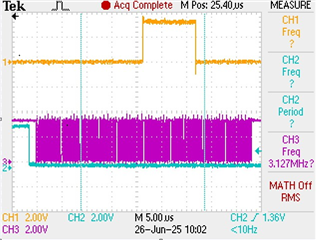Tool/software:
I have been running the ADS8588 dev kit in parallel mode with good results for a few months. This week we decided to convert to a serial interface, and now I am scrambling to get it working as it should.
I set the jumper J3 on the board to select serial mode. The two conversion start pins are tied together. My code issues a reset to the converter for 100ms, and then I have a test program issue a single conversion request, which I can see answered by the BUSY line's pulsing high and then low (this is the blue trace in the images). That low transition is the signal that starts clocking the data in from port A, using a 3MHz clock, plenty slow enough according to the data sheet. You can almost see each packet of sixteen pulses in the purple traces, one burst for each of the eight channels.
The problem is shown in the orange trace. All of my inputs are grounded, and yet the readings are all over the place. Sometimes I get all zeros as I should, or nearly so within the expected margin of error. But other channels may have all their bits high, as if I have applied the full voltage rail to them. I can find no pattern to the behavior. Can someone offer a suggestion based on experience as to what I may be overlooking when moving to the serial interface?
One additional note is that we will not have access to a SPI bus, so I have been clocking the RD line from a PWM generated output on my micro and simply reading whatever is presented on the ADC's data port. Is there a known issue with bit banging the port in serial mode? I appreciate any inputs.
Thanks
Here: grounded channels 4,5,6 and 8 show all high inputs -
Here: now all good except channels 5 and 6...

Now half the channels are good, and half in error:


